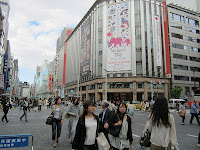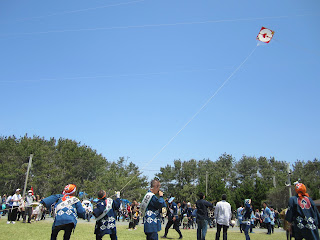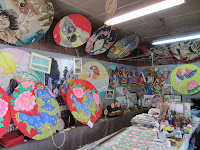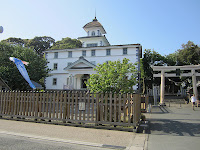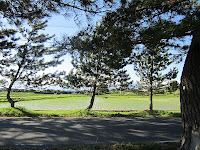2012-05-27
Rose garden @ Ikuta Ryokuchi: May 27, 2012
We had nice early-summer days this weekend. The breeze was nice and the sky was blue.
I visited Ikuta Ryokuchi Rose Garden in Kawasaki City. The garden is open a few weeks in the early summer and autumn respectively.
More the 500 kind of roses are planted. The flower’s red, yellow, pink purple and other colors were impressive. It smelled so good.
The green color of the trees in the hill was also beautiful.
Tokyo Gate Bridge: May 26, 2012
Tens of man-made islands have been built in the Tokyo Bay the last 100 years. Today’s front line of the land is about 6 kilometers away from the line in the early 20th century.
A new bridge named “the Tokyo Bay Bridge” was open last February. The bridge links the Wakasu island and Outer Central Breakwater Reclamation Area.
The bridge is a truss bridge. It is sometimes called “the dinosaur bridge” from its shape.
It runs about 61 meter above the sea level (so that large ships can sail). The highest of the bridge is only 87.8 meter (so that it will not make any trouble on the flight to and from the Haneda Airport nearby).
A Rock concert was held in the Wakasu Park, where the bridge starts. People enjoyed fishing in the wharf under the bridge. Airplanes flied over the bridge.
2012-05-21
Annular eclipse :May 21, 2012
Sanja Festival@ Asakusa:May 19, 2012
The days of Sanja Festival came again. It is held at Asakusa Shrine and is known as one of Tokyo’s most famous festivals.
The festival was not held last year because of the Great East Japan Earthquake last year. Local people, visitors and festival freaks were waiting the event resumed.
It was the second day of three-day festival. There were tens of thousands of visitors in the area. Both Asakusa Shrine and Sensoji Temple stand in a site.
People moved around the area carrying Mikoshi or portable shrines. Local people were wearing happi or traditional costume.
Dogs were also wearing happi costume. Cute trio dogs attracted visitor’s attentions.
Special charity sales to help quake-hit Tohoku district was also held.
Tokyo Sky Tree, the world’s tallest tower, will open on May 22. The scene from Asakusa shrine was beautiful.
2012-05-13
Yoyogi Park: May 13, 2012
It was a nice day today. The season is changing from spring to early summer.
I visited Yoyogi Park for the first time in this spring.
Various aspects of life, culture, nature were there.
I saw:
Japanese, Chinese, Americans, Europeans.
Families, young couples, groups of friends, elders, young people, babies, drinkers.
Dogs, crows, tadpoles,
People playing ball lifting, rope jumping, badminton, volleyball
People playing the guitar, drums, saxophone
Soap bubbles, fountains, a pond
Maple trees, pine trees, chestnuts, roses.
I also visited Thai Festival held in a part of the park. More than 10 thousands people were there. It was far crowded than pervious years.
Ginza: May 12, 2012
We find Japan’s new business and consumption trends every time we visit Ginza, Tokyo’s most famous shopping center.
Shops were holding Mother’s Day special sales. People were enjoying shopping and walking in the early-summer weather.
I visited Uniclo’s new store, which opened in mid March. It is the largest of the company’s about 1100 stores in the world (and about 850 in Japan).
The store is 12-story high. They have floors for women, men and kids. Some floors were used for new type of T shirts and for cool-biz goods.
The shop was crowded. Chinese, Korean and other foreign languages were heard there. The shop is becoming a must-visit place for Asian tourists to Japan, according to some tourist guidebook.
The messages in the electronic display boards were and eye-catching and strong. I felt a sense of speed (unlike other old Japanese companies) in the store.
The changes of luxury brand stores such as Hermes, LOUIS VUITTON and Giorgio Armani are rapid (both in opening/closing and the shop’s renovation). Some stores were different from their appearance three months before.
Special event was held to support Tohoku district, which was hit by earthquake and nuclear disaster last year. 14 months have passed since 3.11, 2011.
Tokyo Port Festival @ Harumi: May 12, 2012
I have already walked many times in the Tokyo Bay area. (see Tokyo Bay Walk 1, 2, 3, 4 )
The festival is held to celebrate the opening of the Tokyo Port in 1941.
Parents were taking pictures of their children with coast guards.
Canals run around the area. Many tall apartments have been built in this 30 years in the area.
2012-05-05
Kite Festival @Hamamatsu: May 5, 2012

I had a little side trip to Hamamatsu City during my Tokaido walk. The visit was to enjoy the city’s famous Kite festival.
Tens of huge kites (more than 3x3 meters large) were flying in the blue sly when I arrived in the festival site near the sea.
The kites are made and raised by more than 100 teams organized by local communities. The designs were different by the teams.
Thousands of tourists were enjoying the festival.
The ropes are more than 1000 meter long. They were using special instruments in addition to men powers to operate the kites.
Competitions to fall another team’s kite were also held. They attacked opponent’s kite by contacting the ropes.
Landing the kite softly seemed difficult. I saw some kites made hard landings to the ground.
It is said that the festival originated about 450 years ago. By raising kites, people celebrated the birth of their first sons. The tradition remains. Some kites are raised to celebrate the birth of new babies.
The sea outside the festival site was wide and wild. The was strong and the ripple marks changed every minutes.
In the night, they had a march of floats in the central city.
Tokaido Walk (20) Fukuroi-Mitsuke: May 5, 2012
Following to yesterday’s walk, I went ahead to Mitsuke, the 28th shukuba station.
Tokaido goes along residential areas and rice and tea fields in this area. Lines of pine trees remain in some places.
I dropped in a kite shop along the street in Fukuroi. Kite-flying has been popular in and around this area.
Mitsuke is in Iwata city, Shizuoka Prefecture. The city is not so big, but is famous as a “sport city”. It host a popular football team Jubilo Iwata. I saw posters, flags and other Jubilo-related things throughout the city. I also found handprints and footprints of football stars copied in the plates in the main street of the city.
Iwata is a home town of Yamaha Motor and has main factories of Suzuki.
The oldest building of the nation’s elementary school remains near Mitsuke station.
Tokaido Walk(19)Nissaka-Fukuroi: May 4, 2012
It is my 4th day of Tokaido Wak this “golden” week holidays. I walked from Nissaka through Kakegawa to Fukuroi.
Fukuroi is the 27th shukuba station from Nihonbashi, Edo (Tokyo). It is the center of 53 stations (excluding Tokyo’s Nihonbashi and Kyoto’s Sanjo-Ohashi, the starting and finishing point of Tokaido). It is about 230 kilometers from Tokyo.
Nissaka is a small station in the mountainous area (as is described in Tokaido Walk (18) blog). Nature-rich shrines and temples stand along the street. The fresh green of tall woods at Kotonomama Hashiman Shrine was so beautiful.
I arrived in Kakegawa station. A castle stands along Tokaido. The castle was rebuilt in 1994. A festival was held at a park in front of the castle.
Kakegawa is known as a place to collect tea leaves and make tea products. I found tea factories along the street.
It is a season when people plant new rice in the flooded fields. I saw paddy fields spread along pine-lined Tokaido in Kakegawa and Fukuroi. It is a scene drawn in many Ukiyoe pictures in the Edo era.
“The middle town of Tokaido” (Tokaido Do-man-naka) is seen everywhere in Fukuroi. The phrase is also found in a entrance plate of an elementary school.
Subscribe to:
Posts (Atom)


























